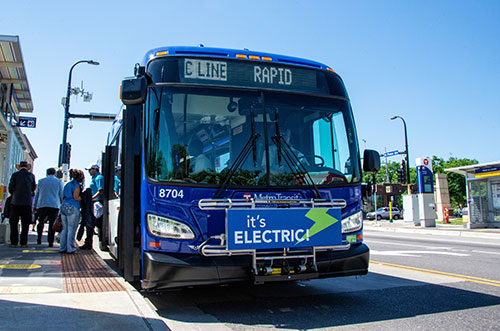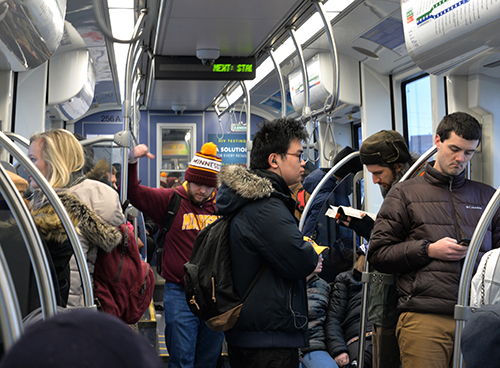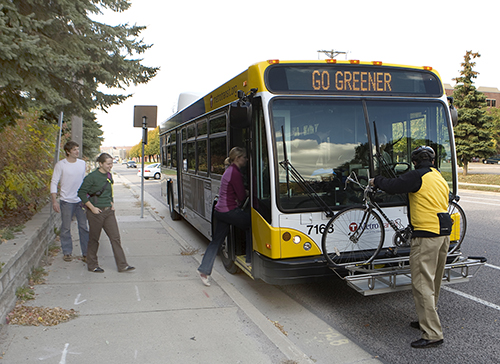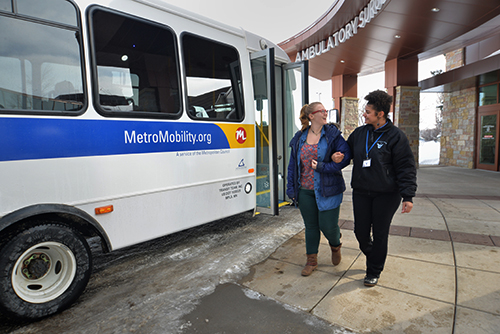 The METRO A Line and C Line bus rapid transit lines tallied nearly 3 million rides in 2019. These are the two most significant recent transit investments to begin operations, and this fast, frequent, and reliable service is quickly becoming the banner of the regional transit system. Just six months into operation, the C Line service closed the year at 1.2 million rides.
The METRO A Line and C Line bus rapid transit lines tallied nearly 3 million rides in 2019. These are the two most significant recent transit investments to begin operations, and this fast, frequent, and reliable service is quickly becoming the banner of the regional transit system. Just six months into operation, the C Line service closed the year at 1.2 million rides.
“We’re really talking about how we move people around and get them where they want to go, like reaching good jobs,” said Metropolitan Council Chair Charlie Zelle. “It’s not just about one transit line, it’s about the whole network. We choose to invest in lines that best build out the system and where riders get what they need. Where we invest in transit, riders follow.”
Governor Tim Walz’s Building One Minnesota plan recommends bonding to help bring two more bus rapid transit lines to the metro area. The METRO B Line will bring faster service to the Route 21 corridor from Uptown Minneapolis to Union Depot in Saint Paul. The D Line will connect from Brooklyn Center through downtown Minneapolis to the Mall of America in the Route 5 corridor.
These corridors are two of the busiest in the system; Route 5 carried over 7% of all bus trips last year and Route 21 carried 6%. The planned investments will improve speed and reliability, making it more efficient and effective to move a larger number of people and connect them to jobs all along the corridor.
 Ridership across the system
Ridership across the system
The METRO A Line bus rapid transit and METRO Green Line light rail each set annual ridership records in 2019. In the line’s third full year of service, A Line customers took nearly 1.7 million rides, a 3% increase from 2018. The Green Line had more than 14.2 million rides in 2019, a 3% increase from the year before. Ridership on the Green Line has risen every year since service began in 2014.
Light rail and bus rapid transit are just a part of the region’s transit system, which also includes local and express bus, commuter rail, on-demand, and contracted services.
Local bus routes continue to carry the bulk of trips across the region, reaching over 47 million rides in 2019. While overall, local and commuter express bus ridership has gone down, there are highlights where spot investments to improve access, speed, or reliability have boosted ridership.
Riders who travel on Metro Transit’s local bus routes 54, 62, 11 and 2 have all benefitted from these investments with improved travel times and on-time arrivals. These investments are focused on ways to improve local service in corridors where bus rapid transit is not planned.
Regional ridership across transit types and providers declined 2.7% overall from 2018 – from 94.2 million rides to 91.5 million rides. Regional providers — Maple Grove Transit, Minnesota Valley Transit Authority, Plymouth Metrolink, and SouthWest Transit — provided nearly 5 million rides, down slightly from 2018. The University of Minnesota held steady with about 4.1 million rides.
Staff will present the full ridership report (PDF) at the March 9 Transportation Committee meeting.
A number of national trends may factor into the ridership decline. Trends like more auto usage because of relatively low interest rates to buy a car and the price of gas, or the impact of emerging travel options like ride-hail services, bike share and scooters. In the metro area, more people are choosing to live in the urban core, particularly University of Minnesota students. In addition, construction in downtown Minneapolis, where many riders transfer, has created detours and delays for several of the region’s busier lines.
 An interconnected transit system with an eye to the customer
An interconnected transit system with an eye to the customer
Our customers value the service, and where we add value to the system with strategies that improve comfort, speed and reliability, riders respond by using the system more. Bringing the community into the planning, decision-making and implementation ensures that we meet our customers’ needs.
“Last year we launched our Network Next effort looking at what our bus system looks like in 2040,” said Metro Transit General Manager Wes Kooistra. “We started with talking to customers, residents, neighborhoods and community organizations, and local partners about how transit works for them today and how it could work better. Now, we’re building a guiding framework that will help us make investment decisions about where we make improvements and how we prioritize those decisions.”
Network Next will result in recommendations for expanding Metro Transit’s local and express bus service, developing new bus rapid transit lines, helping connect people with ways to get from the bus stop to their final destination, and improvements to the customer experience at the stop and onboard the bus.
The Met Council is also studying the complete regional transit system to better understand what parts of transit service are most valuable, and how transit supports the visions of the communities it connects. The study will look at how transit service is distributed across the region today, how it performs, what values it serves, and how these factors influence the future of transit in the region.
These visions will require additional funding for transit expansion, transit operations, new buses, garages and other support facilities. However, a lack of sustainable and reliable funding presents challenges for planning for the preservation and growth of the transit system.
The Motor Vehicle Sales Tax is currently a major source for the transit operating budget, but it’s an unreliable and often volatile funding source. System growth banks on a mix of capital sources from federal funds and state bonds, to county sales tax revenues and Council resources. These dollars are all necessary to build a transit system that better serves everyone.
 Pace of Metro Mobility’s ridership growth slows
Pace of Metro Mobility’s ridership growth slows
Metro Mobility’s ridership grew 2% in 2019 to 2.4 million rides. The average growth had been 6% over the previous 5 years.
The biggest impact to 2019 ridership happened during the first quarter. Severe winter weather, ice storms, and the polar vortex all suppressed ridership.
“We continue to plan for growth in Metro Mobility ridership,” said Nick Thompson, Director of Metropolitan Council Transportation Services, which oversees Metro Mobility operations. “As one of our riders and advisors often says, anyone at any time can become disabled and need this service. This is what we plan for and why we continue looking for ways to improve our services for existing and future customers, like the ride-hail pilot project that will begin later this year.”
Metro Mobility is a shared-ride public transportation service for certified riders who are unable to use regular bus or train routes because of a disability or health condition. The service is on-demand and is mandated under the Americans with Disabilities Act, as well as state law.
Tracking transit use over time
Each year the Met Council compiles data about transit ridership across the seven-county region, from Metro Transit’s bus and rail service to suburban providers’ local and express bus service, to more specialized services. Regional transit ridership combines the number of rides on all types of transit and by all the region’s transit providers.